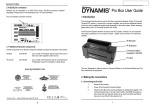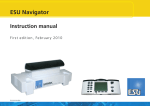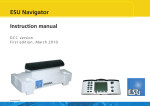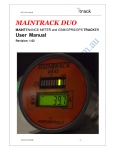Download Bachmann Dynamis User guide
Transcript
Dynamis User Guide 1 Dynamis User Guide Contents Introduction 3 Hardware overview Handset 4 Command station 5 Handset screen overview 6 Action key icons 7 Getting Started 8 How to use the joystick 9 How to configure the locomotive roster 9 How to manage consists 13 How to operate turnouts and accessories 15 How to program locomotive decoder CVs 16 How to configure using the System menu 17 How to make the best of Dynamis on your layout 19 Safety and care of your Dynamis 21 Fault finding 22 Other Bachmann E-Z Command® DCC products 23 Warranty information 23 Technical support 23 Dynamis Menu Reference 24 2 Dynamis User Guide Introduction Thank you for your choice of the Bachmann E-Z Command® Dynamis® DCC model train control system. You have chosen an easy to use yet highly sophisticated product. Please take a few moments to become familiar with the product by reading this manual before proceeding. Using the Dynamis DCC system is simple as all actions are guided by the screen icons with four Action Keys beneath. The Dynamis DCC system features a powerful bi-directional infrared hands- free control unit for convenient operation around your layout. Information passes both ways between Command Station and Handset to ensure communication integrity. Both units have been designed to have a wide transmission and reception arc for optimal performance. Dynamis can be used with model trains of any scale: power hungry Large Scale trains may require the use of the E-Z Command® 5-amp booster. This Dynamis starter system contains: Wireless handset Command Station with receiver Lanyard Track lead AAA / MN2400 /LR03 batteries (4) for handset Mains transformer IMPORTANT Bachmann E-Z Command® Dynamis® runs NMRA DCC decoder fitted trains only: it does not run a train without a decoder. Damage may result to any train without a decoder placed on a track powered by Dynamis. Dynamis is a DCC system which is compliant with the NMRA DCC standards 3 Dynamis User Guide Hardware overview Joystick The Handset infra-red receiver / transmitter Battery compartment Battery compartment Screen Direction Keypad for direct control Headlights Lanyard fixing of up to 21 Locomotive Emergency stop functions, headlights accessory on/off hotkeys and On / off switch Shift key to switch alpha numerical between the function keypad for keys operating F1 to loco and F10 and F11 to F20. accessory Action keys In accessory mode address entry sets function keys to Left hand is MODE key to switch be accessory hotkeys between locomotive and accessory control 4 Dynamis User Guide The Command Station DC power pack connector Use only the supplied wall transformer Receiver connection Output connectors, 3.5mm jack or plug with screw terminal Receiver LEDs There are indicator LEDs located within the receiver NORMAL OPERATIONS Left hand - constant indicating power to Command Station Right hand - flashes on receipt of Handset signals STOP pressed / short circuit on track Left hand flashes HANDSET OUT OF RANGE OF COMMAND STATION Left hand and Right hand both flash rapidly 5 Dynamis User Guide Handset screen overview Indicators for decoder function status on/off Shift key pressed indicator Consist indicator Headlights on indicator Text, including loco details and menus etc Track short circuit reported by Command station STOP indicator Low battery power infra-red signal condition Used only when the Dynamis Pro Box is also used Speed and direction indicators Action Key icons 6 Dynamis User Guide Action key icons Icon Key purpose when icon shown Referred to as Add loco to / remove from Consist [CONSIST] Select locomotive by address [LOCO] Turnout / accessory operation - turnouts left / right or accessories on / off [DIVERGE] or [STRAIGHT] Access the menu [MENU] Accept [ACCEPT] [CANCEL] Cancel Scroll left or right Move between CV selection and value for CV in the programming menus [SCROLL] [CV<>] [<>VALUE] (reading CV values requires Dynamis ProBox) [READ] [PROG] Backspace in text entry [BKSP] Write value to CV / read from CV 7 Dynamis User Guide Getting Started 1. Attach lanyard to the handset. To avoid dropping the unit use the lanyard around neck or wrist. 2. Insert 4 AAA batteries into handset orientating as shown on the diagram. The battery covers are removed by carefully releasing the clips at the rear of the handset 3. Connect receiver to terminal on top of the Command Station. 4. Place Command Station by layout, locating in a position with a good angle of view to the Command Station infra-red receiver. Remove existing controllers / power packs and connect the wires to the Command Station. Use the red lead with jack plug to connect to Bachmann E-Z Track® or the Bachmann Branchline track powerclip Other leads with bare wire connectors can be connected to the green connector block which plugs to the Command Station. This is recommended for layouts using higher track power. Please refer to ‘How to make the best of Dynamis on your layout’ section for advice on connecting to existing layouts 5. Select the appropriate mains pins for the wall transformer: they fit and lock in place with a twist action. THIS PROCEDURE SHOULD BE CARRIED OUT BY AN ADULT 6. Connect the power supply lead to the Command Station. Plug the transformer into wall socket. The LED on the Command station receiver will be illuminated. 7. Turn on the Handset with the switch underneath – the Handset always powers up with the STOP cutout in place (press STOP button to proceed) and ready to run a locomotive with address 3. 8. Place a locomotive on the track. New DCC locomotives or decoders are shipped with an address of 3. To run a locomotive with a different address, press [LOCO] key and then enter locomotive address and press [ACCEPT]. This locomotive number shows on the screen along with a default roster entry that has been created. 8 Dynamis User Guide How to use the joystick Increase speed, scroll through menus, text input Scroll through locomotives roster and menus, text input Decrease speed, scroll through menus, text input 9. Push the joystick upwards to move the locomotive, bring it downwards to bring the locomotive to a stop. Change direction by pressing the direction button beneath the joystick. 10. Leaving the first train running, select a second locomotive address using the joystick or the [LOCO] key. Set the train running. Move back to the first train by scrolling with the Joystick. When selecting another moving train the bar graph for speed immediately shows current speed of that train so that any change to speed is made from the speed at which it is currently travelling. How to configure the locomotive roster There is a 40 locomotive roster database recording details of the locos. When first selecting a locomotive address to run a roster entry is created with default values. Once there are 40 roster entries one must be deleted to allow any other locomotives to be run. EXAMPLE: Changing the address and defaults of locomotive A short (up to 127) or long addresses (“4-digit”) can be written to a decoder by programming using a Service Track with no other locomotives present otherwise all locomotives will adopt the address. If necessary create a separate length of track powered by your Dynamis for this purposes. Additonally, a short address can be changed to another short address using Main Track / “Ops mode” programming if 9 Dynamis User Guide the decoder allows (please check with decoder instructions: for example Bachmann 36-553 and 36-554 decoders will allow this) whilst other locomotives are on the track. Main track Service track YES YES Short address with decoder not allowing Address (CV 1) to be programmed on Main Track NO YES Long address using any decoder NO YES Short address to another short address with decoder allowing Address (CV 1) to be programmed on Main Track If in doubt about the decoder specification, use the SERVICE TRACK to write the address. The screen shows LOC 0003 LOCOMOTIVE 0:28 0003 1. Changing the locomotive address The locomotive address can be set in either of two ways Service Track Main Track - all addresses 0001 to 9999 short addresses 1 to 127, only if allowed by the decoder Using Main Track to change a short address to another short address [MENU] -- scroll to -- scroll to PROGRAM WRITE ADDR 0003 ON MAINTRACK Screen shows CHANGE ADDR LOC WRITE ADDR 3 10 [ACCEPT] [ACCEPT] Dynamis User Guide [BKSP] to delete existing address Use alphanumeric keys or joystick to enter new address up to 127 CHANGE ADDR 0003 WRITE ADDR 68 Press [PROG] to write the new address Both decoder and roster database are updated. Using Service Track [MENU] -- scroll to -- scroll to PROGRAM WRITE ADDR 0003 ON SERVICETRACK [ACCEPT] [ACCEPT] Screen shows WRITE ADDR LOC WRITE ADDR 3 [BKSP] to delete existing address Use alphanumeric keys or joystick to enter new address of up to 4 digits CHANGE ADDR 0003 WRITE ADDR 4468 Press [PROG] to write the new address Both decoder and roster database are updated. 2. Changing the locomotive name Each locomotive in the roster can be given a name of up to 16 characters, which could be its actual running number if longer than 4 digits. Choose any combination of letters and numbers using the alphanumeric lettering by each function key to enter the name. [MENU] EDIT NAME LOCOMOTIVE 3 [ACCEPT] SET NAME LOCOMOTIVE 3 11 Dynamis User Guide [BKSP] to delete ‘LOCOMOTIVE 3‘ Use alphanumeric keys or joystick to enter new name MALLARD [ACCEPT] 3. Changing the locomotive icon Each entry in the roster can be given an indicative icon for the type of locomotive, or none. [MENU] scroll to EDIT SYMBOL 4468 MALLARD [ACCEPT] SET SYMBOL Scroll through the icons for DIESEL, STEAM, ELECTRIC or none Choose STEAM [ACCEPT] 4. Changing locomotive decoder speed steps Most decoders operate on 28 or 128 speed steps. Consult your decoder instructions for information. [MENU] scroll to EDIT SPEED 4468 MALLARD [ACCEPT] Scroll SET SPEEDSTEPS 14 / 28/ 128 speedsteps Choose 128 [ACCEPT] 5. Changing the function setting 12 Dynamis User Guide The control of each function on the decoder locomotive can be set to latch or trigger Latch – once pressed the function output is activated until the key is pressed again to turn off Trigger – the function is only activated for the duration of the press Example: The headlights of a locomotive would have a latch setting so that the are left on until turned off again. A coupling sound would have a trigger setting so that it can be played when required with a key press. [MENU] EDIT FXMODE LOCOMOTIVE 4468 [ACCEPT] SET FUNCTIONS LATCHING Use the function keys to select the function outputs of the decoder that are to latch. When the indicator shows on the screen the function is set to latch. [ACCEPT] The Screen now shows LOC 4468 MALLARD 1/128 6. Deleting a locomotive The roster entry can be deleted when no longer required. The currently controlled locomotive cannot be deleted unless it has a speed of 0. How to manage consists 13 Dynamis User Guide ‘Consist’ is a term used to describe more than one locomotive or railcar each with its own decoder address being run at the same time as a single entity. ‘Double header’ or ‘multiple unit’ might also be used, but for simplicity the term ‘consist’ will be used here. 1. To add current loco to a consist: NOTE a locomotive in a consist may have to run ‘backwards’ when the consist is running forwards – for example a pair of diesel locos with their cabs outwards. Use [DIRECTION] to set one of the pair in the reverse direction before putting in the consist. Press [CONSIST] ADD TO CONSIST CONSIST ID 0 - choose a consist number in range 1 to127 A consist cannot have the same number as a locomotive already in the roster [CANCEL] to cancel [ACCEPT] to accept CONSIST TYPE Scroll to choose UNIVERSAL or ADVANCED Universal Consists are handled by the Dynamis unit Advanced Consists are a decoder feature – check that the decoder you are using has CV19 to allow this feature. The consist indicator will now be showing against this locomotive Each consist has it own place in the roster. UNI ADV C001 indicates consist 001 is universal C002 indicates consist 002 is advanced [ACCEPT] Each consist can be given a name 14 Dynamis User Guide eg PAIR OF 20s or UP DASH 8s or TWO BR 218s The consist can be controlled by: Either consist address or any of the individual locomotive addresses Locomotive functions are controlled from the locomotive address. 2. Removing a loco from a consist Scroll through the roster to the locomotive. Press [CONSIST]. The locomotive is removed and the consist indicator no longer shows. 3. Deleting a consist Once empty, a consist record can be deleted How to operate turnouts and accessories Press [MODE] to move the Handset into accessory mode Screen shows ACC A001 :01/1: This indicates accessory address 1 which is accessory decoder 1, output 1, assuming standard 4-output units Scroll to using joystick, or enter an address with the numeric keys ACC A067 :17/3 Accessory address 67 accessory decoder 17, is output 3 Addresses up to 100 (25 decoders) can be supported Change direction by pressing [DIVERGE] or [STRAIGHT] Creating accessory hotkey 15 Dynamis User Guide A ‘hotkey’ shortcut from the numeric keypad can be set. The actual address of any particular accessory can be assigned to any of the 10 hotkeys available. By default, the hotkeys are accessory addresses 1 to 10. For example, the 10 most important turnouts on the layout can be given the shortcut. In accessory mode SCROLL to the accessory address to be given an hotkey [MENU] edit Hotkey A060 [ACCEPT] Set HOTKEY HOTKEY 0 | A005 Enter the hotkey to be given to this accessory address [SELECT] Using an accessory hotkey Press [SHIFT] when in accessory mode. Keys [F1] to [F10] control the 10 accessories given a hotkey shortcut. Change direction by pressing [DIVERGE] or [STRAIGHT] Programming an accessory decoder Please refer to the instructions accompanying the E-Z Command Dynamis accessory decoder (item number 36-561) or E-Z Track digital turnout or www.dynamisdcc.com for more information. How to program locomotive decoder CVs CVs - ‘Configuration variables’ - are storage slots within the decoder which hold values to control its performance. Different decoders have a differing selection of CVs according to their specification. They control many different aspects of the decoders performance: eg maximum or minimum speed, how the headlights operate or whether the decoder operates on a DC supply. Refer to the instruction sheets that came with your decoder or locomotive for details of the features that are on your particular locomotive’s decoder. Dynamis has the capability of programming in one of two methods: ‘Operations Mode’ (also called ‘Main track programming’) - other locomotives can be left on the track as the programming instruction is sent to the particular decoder address. ‘Service Mode’ makes the entire layout a service track. All decoders present on the layout will receive the programming instruction. Other locomotives should be 16 Dynamis User Guide removed from the track if using this method, or the locomotive programmed on an isolated Service Track. Decoders that do not accept Operations Mode programming should be programmed on a Service Track. Service mode also allows decoder CV values to be read: this is possible using the Dynamis ProBox. Service Mode can be any of the following according to the requirements of the decoder: Direct mode ‘CV’ Paged mode ’PM’ Register mode ’RM’ Each with or without programming track power down Most modern decoders work with Direct mode programming. Dynamis allows any or all of these methods to be set for a single programming session: adding modes adds to the time taken to program. Select the programming methods required using the System menu (see page 18). Setting of locomotive decoder addresses is covered in ‘How to configure the locomotive roster’ on page 10. Some CVs are common to all decoders, eg CV 2 start speed or CV 29 configuration. Others are specific to the decoder. The Handset shows the description of common CVs. EXAMPLE To restrict the the maximum speed of a locomotive using Main Track programming PROGRAM 4468 ON MAINTRACK [ACCEPT] POM CV 0 VAL 0 00000000 Set the value contained in CV5 to 20 POM CV 5 V HI [<>VALUE] VAL 20 [PROG] the chosen value is written to the decoder [CV<>] to continue programming another CV or [CANCEL] to return to menu 17 Dynamis User Guide How to configure using the System menu Please refer to the full menu breakdown at page 24. Joystick speed delay Determines time before the speed repeat action is in effect. Joystick speed repeat Determines the rate of increase of speed on joystick movement. Adjustment to these two settings changes the way the Handset actions speed increases in response to joystick movements Joystick menu delay Determines time before move to the next menu item when the joystick is held to left or right. Joystick menu repeat Determines speed of scroll through menus. Adjustment to these two settings changes the way Handset moves through the menus in response to joystick movements Backlight brightness A higher value gives greater intensity of illumination. Backlight duration Sets the length of time before the screen backlighting illumination turns off. A higher value gives a longer period of illumination. A setting of 0 means the back light remains on constantly. Edit stop mode Set to either POWER OFF to cut the power from the track to stop all trains running or ESTOP LOCOMOTIVE to bring the train currently under control to a stop. Any other trains running will continue. Holding down the STOP button for a few seconds cuts the power from the track to stop all trains. It’s recommended that the ESTOP LOCOMOTIVE setting is for advanced users only. 18 Dynamis User Guide Edit track timeout The Dynamis Handset and Command Station stay in contact. If the line of sight is lost the Command Station cuts track power. Use this setting to adjust the length of time before power is cut when contact is lost. Edit Service Track Programing Selects the modes used for Service Track programming. Select a combination of the programming methods according to the requirements of the decoder being programmed. Direct ‘CV’ Paged mode ’PM’ Register mode ’RM’ With or without programming track power down. èMost decoders will accept Direct Mode - leave at this setting unless a decoder has another requirement. Please consult you decoder instructions. More programming methods in use at one time increase the time to program. Factory reset Restores the default values, deleting all locomotives that are stored in the roster database. Edit base ID 4 infra-red channels are available so that different layout in proximity can be controlled. The Command Station jumper and the handset to must operate on the same channel. Leave at 0 unless two or more Dynamis systems are being used in close proximity. Edit base name Allocates a name to the Command Station - used with the ProBox only Edit remote name Set a name for the Handset. How to make the best of Dynamis on your layout What kind of turnouts should be used? Either ‘live’ or ‘dead’ frog turnouts can be used with Dynamis, to the layout builder’s choice – dead frog turnouts are easier to install as the live frog turnout usually requires extra wiring. Details of the requirements included with the particular products. 19 Dynamis User Guide For best results on a DCC layout, turnouts that do not self isolate are required. (Self isolating turnouts are those that enable a train to be parked in a siding on a DC layout when the turnout is closed against it.) Ideally the whole layout should be live so that trains stationary in sidings can have lights on and make sound. If using Bachmann track products: E-Z Track ® can be used without modification because the turnouts do not self isolate. Branchline track does self isolate. The turnouts can be modified simply by placing staples (larger, staple gun type) at the locations indicated although permanently wired connectors would be recommended for a permanent layout to ensure reliable operation. Connecting to an existing layout When connecting Dynamis to an existing layout, existing controllers should be disconnected and all block switches (if any) turned on to put power to the whole layout. High frequency track cleaners should be removed. Reversing or station stop modules used on DC layouts cannot be used on a DCC and should be removed. Do not use track power connectors that incorporate interference suppressors. Service Mode programming and a Service Track ‘Service Mode’ programming makes the whole layout a Service Track and all decoders present on a layout will respond to the programming instructions. Unintended programming operations can be avoided by either: 20 Dynamis User Guide - remove all other locomotives from the track whilst programming Or: create an isolated section of track to be a separate Service Track. Either disconnect your Dynamis Command station from the layout and connect to short length of track, or create separate block section on the main layout that can be separated from the remainder with a switch. What is the rating of the track power? The voltage is stabilised at 15.5v ± 5%, with 2.3 amps of power. How to use one Dynamis system in proximity with another So that multiple Dynamis systems can be used in proximity, there are 4 infra-red signal channels available. The default setting of 0 should not be changed unless necessary to avoid a conflict with another Dynamis system in use in close by. Set the jumper plugs to the pins below the unit to use channels 1, 2 or 3 instead of 0, to match the channel set on the Handset. The pins are marked under the unit. Channel 0 uses no jumper plugs. Safety and care of your Dynamis Use under adult supervision. Only use the supplied power supply, taking care with the power lead. The appropriate mains pins for the local electricity supply requirement should be fitted by an adult: THE MAINS TRANSFORMER AND ITS PINS ARE NOT A TOY. Do not use if the cable becomes damaged. Contact a Bachmann Service Department should a replacement power supply be required. 21 Dynamis User Guide Use only for the control of model trains. Wipe only with a damp cloth - do not immerse in water or use any other cleaning agents. For indoor use only - don’t allow to become wet. The handset is a precision item and should be treated with care - always use the lanyard to avoid dropping. Batteries Use AAA / MN2400 / LR03 batteries Alkaline or NiCad or NiMH rechargeable batteries are suitable Insert into the handset with correct polarity Follow guidelines on the use and disposal of batteries Remove batteries from the handset when not in use to avoid damage from leakage Fault finding I can’t run a train with my Dynamis system Power supply not connected to Command Station - LEDs will illuminate on Command Station when power is applied. Connect power. No connection to track - check connections. Battery low indicator on Handset - replace batteries. STOP or Short circuit indicator on Handset - check cause and press STOP to reset unit. Handset out of range of Command Station- STOP will be illuminated - press to reset. The LED on the Command Station receiver flashed when signals are received. Incorrect address of loco selected - check loco address and select locomotive with correct address. Handset and Command Station not on same channels - check setting of Handset and set Command Station jumpers to the same channel. 22 Dynamis User Guide Other Bachmann E-Z Command® DCC products that can be used with Dynamis 36-507 Dynamis ProBox Upgrade your Dynamis system to operate with up to 4 wireless handsets, plus a programming track, a bus connector for wired throttles and devices, and more. 36-561 E-Z Command® accessory decoder for turnouts etc 36-520 E-Z Command® 5 Amp Power Booster 36-525 E-Z Command® Reversing Loop Module Bachmann E-Z Command® decoders and DCC Onboard models are also available from your retailer. Warranty information Please refer to the enclosed sheet accompanying this user guide. Technical support Visit the Dynamis website www.dynamisdcc.com for technical information, updates and further information or conctact us at one of these addresses. Bachmann Industries, Inc 1400 East Erie Avenue Philadelphia PA 19124 USA Tel: 1-800-356-3910 Bachmann Europe PLC Moat Way Barwell Leicestershire LE9 8EY United Kingdom Tel: + 44 1455 841756 Niederlassung Deutschland Am Umspannwerk 5 90518 Altdorf b. Nürnberg Germany Tel: + 49 9187 97220 Dynamis is a registered trademark of Bachmann Europe plc E-Z Command and E-Z Track are registered trademarks of Bachmann Industries, Inc 23 24 1 EDIT NAME | | | EDIT SYMBOL | | EDIT SPEED | | EDIT FX MODE | | | | | DELETE LOCO or CONSIST | | PROGRAM | | | | Choices to accept to cancel to accept to cancel to accept to cancel SET SPEEDSTEPS SCROLL: 14 / 28 / 128 Sets speed steps decoder is operating at SET FUNCTIONS TO LATCHING SELECT: F0 / F1 / F2 / F3 / F4 / F5 F6 / F7 F8 / F9 / F10 / F11 / F12 /F13 F14 / F15 / F16 / F17 / F18 / F19 / F20 Sets individual functions to latch or trigger CONFIRM DELETE Deletes locomotive or consist record from database WRITE ADDR ON MAINTRACK Writes a locomotive address using Programming on Main / Ops Mode | WRITE ADDR ON SERVICETRACK Writes a locomotive address using Service Mode* to accept to cancel to accept to cancel Action SET SYMBOL SCROLL: Diesel / Steam / Electric / None Choose indicative symbol for locomotive or consist SET NAME KEY: up to 16 characters free text Set 16 character name for locomotive or consist Option Press [MENU] and scroll the menu with [SCROLL] or the joystick Press [CANCEL] to move back up the menu Dynamis Menu Reference Dynamis User Guide 2 | READ ADDR ON SERVICETRACK | Reads address using Service Track | (Function operates with DYNAMIS PRO box only) | | | PROGRAM ON SERVICE TRACK POS CV number | VAL value | | | PROGRAM [CURRENT LOCO]ON MAINTRACK POM CV number | VAL value | | SYSTEM MENU | EDIT BASE ID SET BASE ID Enter number | Default = 0 Range 0-3 | EDIT REMOTE ID SET REMOTE ID Enter number | (Feature set with DYNAMIS PRO box only) | SYSTEM INFO -------| | EDIT BASE NAME SET BASE NAME Enter name | | | | | | BASE SERIAL NUMBER U00000000 | | | | | BASE INFO_0 version number Read Only | | | EDIT REMOTE NAME SET REMOTE NAME Enter name | | Default: Dynamis Remote Dynamis Menu Reference to accept to cancel to cancel to accept to cancel to accept to cancel to accept to cancel to accept to cancel Dynamis User Guide 25 26 | | | REMOTE INFO | EDIT JOYSTICK SPEED DELAY | | EDIT JOYSTICK SPEED REPEAT | | EDIT JOYSTICK MENU DELAY | | EDIT JOYSTICK MENU REPEAT | | EDIT BACKLIGHT BRIGHTNESS | | EDIT BACKLIGHT DURATION | | EDIT STOPMODE | | | EDIT SRV TRK PROG | | | | | Dynamis Menu Reference 3 to accept to cancel to accept to cancel to accept to cancel to accept to cancel SET JOYSTICK MENU REPEAT Enter value Default = 63 Range 0 - 63 SET BACKLIGHT BRIGHTNESS Enter value Default = 6 Range 0 - 8 SET BACKLIGHT DURATION Enter value Default = 60 Range 0 - 255 SET STOPMODE SCROLL: POWER OFF / ESTOP LOCOMOTIVE Sets action on use of STOP button Default = Power off SCROLL: CV Powerdown CV RM CV RM Powerdown CV PM CV PM powerdown CV PM RM to accept to cancel SET JOYSTICK MENU DELAY Enter value Default = 8 Range 0 - 63 SET SRV TRK PROG to accept to cancel SET JOYSTICK SPEED REPEAT Enter value Default = 12 Range 0 - 63 to cancel to accept to cancel Read Only SET JOYSTICK SPEED DELAY Enter value Default = 8Range 0 - 63 version number Dynamis User Guide | | | | | | | | | | EDIT TRK TIMEOUT | | | FACTORY RESET Dynamis Menu Reference 4 ARE YOU SURE ? Reset the default values to accept to cancel SET TRK TIMEOUT SCROLL: No timeout / 7.5 sec / 15 sec / 30 sec to accept Default = 30 sec to cancel CV PM RM powerdown RM RM powerdown PM PM powerdown PM RM PM RM Powerdown CV Select Service Track programming methods to use to accept Default = CV Powerdown to cancel Dynamis User Guide 27 Dynamis User Guide Visit the Dynamis website www.dynamisdcc.com Text copyright © 2007 Bachmann Europe plc Printed in China Dynamis User Guide V01 Aug 07 28





































